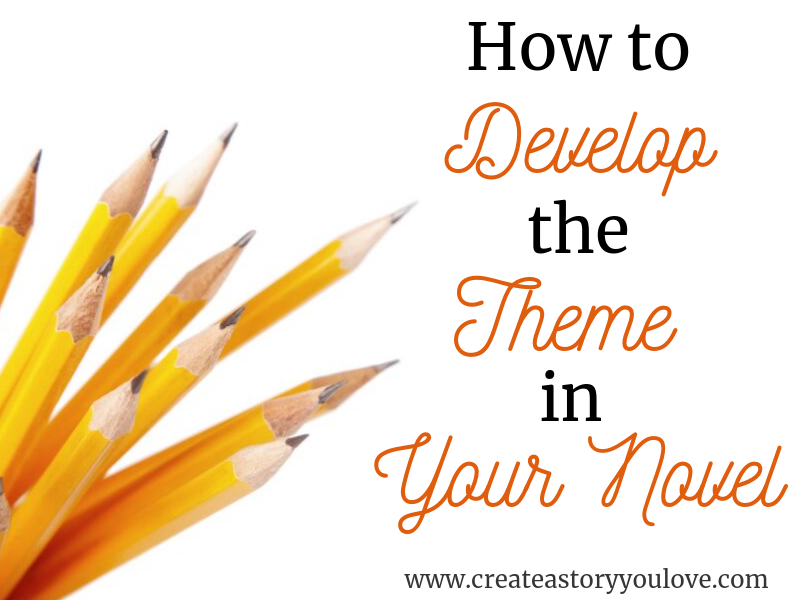When you write a story, do you think about your theme? Honestly, I didn’t give it too much thought in my first novel. I’ve been researching and learning about how to develop theme and found some helpful tips in Nancy Kress’s very helpful book Characters, Emotion & Viewpoint: Techniques and Exercises for Crafting Dynamic Characters and Effective Viewpoints (Write Great Fiction)
I discovered I need to ask more questions and to dig deeper into my character’s background. To go beyond the first thoughts of how I see my character and her story and to really think about her flaws and fears. This has been really helpful as I’m in rewriting mode with the next book in the series right now.
Learning about theme and character arc is so important that I added them to Module 2 in the online class I’m creating now on how to Write and Publish Your First Book. It’s been so much fun to dig deeper into how character arc and theme works in a good story.
So this post is to share about what I’ve been learning about theme and character arc. Maybe some of these thoughts will help you as you write your novel. 🙂

Character Arc
Themes rise organically out of different story elements. It’s really helpful if you can learn how to find your story’s themes as early as when you’re planning your novel. You’ll probably find even more as you edit and do your rewrites.
Start With Your Protagonist
It’s important to start with the main character as our story’s theme ties the protagonist’s internal journey to the external plot.
We show the character’s arc – and the theme of the story – when we write about the protagonist’s worries, goals and lessons she’s learned.
Ideally in the planning stages(or in rewrites as I’m doing) do what you can to figure out everything you should know about your protagonist. Not just how they look, or skills or personality, but also what makes them vulnerable. Ask what their flaws and fears are. Does she have secrets?
I’ve been learning that how your character perceives her past and herself is critical in the search for the theme of your story.
Digging Deeper…
Also take time to think about your protagonist’s past. What was her childhood like? What were some of her happiest, lowest and most embarrassing moments? Did she go through some sort of trauma with her family, friends or health?
I asked a few of these questions of my main character, Annaveta. She sees herself as unworthy of love because of how her own father abused and misused her. This false belief that she’s not worth of love, becomes more emphasized when she faces the tragedies she goes through in the first book.
In this second book her outward journey mirrors that of her inner journey – that of unraveling the truth of her identity – where she came from and her perception changes as she realizes that there’s more treasure in who she is and where she came from than she realizes. I love the character’s journey. It’s probably why I get teary from inspiring movies too.
Probing for False Beliefs
Many character’s carry around false beliefs or untruths that the character has been conditioned to believe are true about herself or the world around her. These false beliefs often show up out of traumatic experiences or emotional wounds. They can taint a character’s worldview and cause her to change her behavior so she can avoid being hurt in the same way again.
It’s the same with all of us as humans. We all suffer from false beliefs or have experienced woundings in our past. We might believe we are deserving of our pain, or that we’re unlovable or that people can’t be trusted. The sad part, is that we hold onto those lies for years and sometimes even decades.
Even though we might have warped perceptions, other people don’t usually see us the same way we see ourselves. Most likely, you won’t share your protagonist’s false beliefs about herself or the world. In fact, you might have already known the twisted way she sees herself is untrue.
Something to try: Free-write for 15 minutes about your protagonist. Write down everything you can think of about her past(childhood, trauma) her present(strengths, flaws, perceptions) and her future (goals and desires). Make a list of her false beliefs. You’ll spot these when your instincts tell you your protagonist is wrong.
The challenge for us as storytellers, is to prove your protagonist’s false beliefs are wrong. To make her change how she thinks about herself.
When your protagonist lets go of her false beliefs is your characters growth arc and it’s also where you’ll find the story’s themes.
It’s the same when we as humans let go of untruths or doubts. Many times we’re changed for the better. But, before that can happen, something causes us to question our warped perceptions and false beliefs. That’s where the journey to letting go of false belief starts.
So, a character arc should reverse a character’s false belief. In the example of Annaveta, when she realizes that she is worthy of love, she discover’s more of who she is(identity) and power and courage.
I love the character’s journey and how through letting go of false beliefs about themselves and the world around them, they begin to create a life they love.
Do you have a pretty clear understanding of the character arc and theme of your story? I’d love to hear your thoughts in the comments. 🙂
